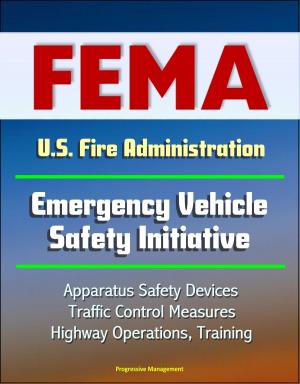21st Century U.S. Military Manuals: Noncombatant Evacuation Operations (FM 90-29) Security, Logistics, Psychological (Value-Added Professional Format Series)
Nonfiction, Science & Nature, Technology, Military Science, Social & Cultural Studies, Political Science| Author: | Progressive Management | ISBN: | 9781465727664 |
| Publisher: | Progressive Management | Publication: | September 9, 2011 |
| Imprint: | Smashwords Edition | Language: | English |
| Author: | Progressive Management |
| ISBN: | 9781465727664 |
| Publisher: | Progressive Management |
| Publication: | September 9, 2011 |
| Imprint: | Smashwords Edition |
| Language: | English |
Professionally converted for accurate flowing-text e-book format reproduction, the Noncombatant Evacuation Operations Field Manual (FM 90-29) covers the evacuation of noncombatants (civilians) under nonemergency conditions.
In the preface, it states:
"Field Manual (FM) 90-29 establishes Army guidance for planning, coordinating, and executing noncombatant evacuation operations (NEOs) under nonemergency conditions. Nonemergency conditions are those in which full mobilization has not been authorized but deployment of combat forces or the use of force may be required to accomplish the mission. The manual provides direction to Army commanders and staffs charged with duties related to these operations. It attempts to harmonize procedures and terminology between the various government agencies that may be involved. Commanders with this type of mission should ensure that their planning staff is acquainted with reference publications to reduce the potential for flawed coordination and mission execution."
Some highlights of the contents:
"Noncombatant evacuation operations (NEOs) are conducted to evacuate civilian noncombatants and nonessential military personnel from locations in a foreign (host) nation during time of endangerment to a designated safehaven. NEOs are normally conducted to evacuate United States (US) citizens whose lives are in danger from a hostile environment or natural disaster. NEOs may also include the evacuation of US military personnel and dependents, selected citizens of the host nation (HN), and third country nationals. NEOs would not normally include retrograde operations of military personnel solely as part of a military operation. NEOs involve swift, temporary occupancy of an objective and end with planned withdrawals. They may include the use of force. If so, the commander limits the amount of force to that required to protect the evacuees and the evacuation force. Every US embassy is required to maintain an emergency action plan (EAP), which includes an NEO plan. The Department of State is the lead agency for planning and conducting NEOs. NEO plans consider HN assets as the primary source of security, transportation, and temporary facilities.
As a bonus, this reproduction includes FM-1, The Army Field Manual, a capstone manual containing the vision for the Army - sold separately for $5.99. FM 1 establishes the fundamental principles for employing Landpower. The most important of these are the Army's operational concept and the fundamentals that support it. They form the foundation for all Army doctrine. All Soldiers should understand and internalize them. FM 1 describes the American profession of arms, the Army's place in it, and what it means to be a professional Soldier.
This is a privately authored news service and educational publication of Progressive Management.
Professionally converted for accurate flowing-text e-book format reproduction, the Noncombatant Evacuation Operations Field Manual (FM 90-29) covers the evacuation of noncombatants (civilians) under nonemergency conditions.
In the preface, it states:
"Field Manual (FM) 90-29 establishes Army guidance for planning, coordinating, and executing noncombatant evacuation operations (NEOs) under nonemergency conditions. Nonemergency conditions are those in which full mobilization has not been authorized but deployment of combat forces or the use of force may be required to accomplish the mission. The manual provides direction to Army commanders and staffs charged with duties related to these operations. It attempts to harmonize procedures and terminology between the various government agencies that may be involved. Commanders with this type of mission should ensure that their planning staff is acquainted with reference publications to reduce the potential for flawed coordination and mission execution."
Some highlights of the contents:
"Noncombatant evacuation operations (NEOs) are conducted to evacuate civilian noncombatants and nonessential military personnel from locations in a foreign (host) nation during time of endangerment to a designated safehaven. NEOs are normally conducted to evacuate United States (US) citizens whose lives are in danger from a hostile environment or natural disaster. NEOs may also include the evacuation of US military personnel and dependents, selected citizens of the host nation (HN), and third country nationals. NEOs would not normally include retrograde operations of military personnel solely as part of a military operation. NEOs involve swift, temporary occupancy of an objective and end with planned withdrawals. They may include the use of force. If so, the commander limits the amount of force to that required to protect the evacuees and the evacuation force. Every US embassy is required to maintain an emergency action plan (EAP), which includes an NEO plan. The Department of State is the lead agency for planning and conducting NEOs. NEO plans consider HN assets as the primary source of security, transportation, and temporary facilities.
As a bonus, this reproduction includes FM-1, The Army Field Manual, a capstone manual containing the vision for the Army - sold separately for $5.99. FM 1 establishes the fundamental principles for employing Landpower. The most important of these are the Army's operational concept and the fundamentals that support it. They form the foundation for all Army doctrine. All Soldiers should understand and internalize them. FM 1 describes the American profession of arms, the Army's place in it, and what it means to be a professional Soldier.
This is a privately authored news service and educational publication of Progressive Management.















